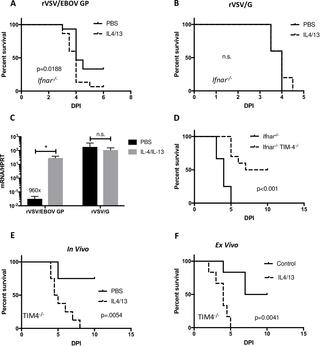当前位置:
X-MOL 学术
›
PLOS Negl. Trop. Dis.
›
论文详情
Our official English website, www.x-mol.net, welcomes your
feedback! (Note: you will need to create a separate account there.)
IL-4/IL-13 polarization of macrophages enhances Ebola virus glycoprotein-dependent infection.
PLOS Neglected Tropical Diseases ( IF 3.4 ) Pub Date : 2019-12-11 , DOI: 10.1371/journal.pntd.0007819 Kai J Rogers 1 , Bethany Brunton 1 , Laura Mallinger 1 , Dana Bohan 1 , Kristina M Sevcik 1 , Jing Chen 1 , Natalie Ruggio 1 , Wendy Maury 1
PLOS Neglected Tropical Diseases ( IF 3.4 ) Pub Date : 2019-12-11 , DOI: 10.1371/journal.pntd.0007819 Kai J Rogers 1 , Bethany Brunton 1 , Laura Mallinger 1 , Dana Bohan 1 , Kristina M Sevcik 1 , Jing Chen 1 , Natalie Ruggio 1 , Wendy Maury 1
Affiliation

|
BACKGROUND
Ebolavirus (EBOV) outbreaks, while sporadic, cause tremendous morbidity and mortality. No therapeutics or vaccines are currently licensed; however, a vaccine has shown promise in clinical trials. A critical step towards development of effective therapeutics is a better understanding of factors that govern host susceptibility to this pathogen. As macrophages are an important cell population targeted during virus replication, we explore the effect of cytokine polarization on macrophage infection.
METHODS/MAIN FINDINGS
We utilized a BSL2 EBOV model virus, infectious, recombinant vesicular stomatitis virus encoding EBOV glycoprotein (GP) (rVSV/EBOV GP) in place of its native glycoprotein. Macrophages polarized towards a M2-like anti-inflammatory state by combined IL-4 and IL-13 treatment were more susceptible to rVSV/EBOV GP, but not to wild-type VSV (rVSV/G), suggesting that EBOV GP-dependent entry events were enhanced by these cytokines. Examination of RNA expression of known surface receptors that bind and internalize filoviruses demonstrated that IL-4/IL-13 stimulated expression of the C-type lectin receptor DC-SIGN in human macrophages and addition of the competitive inhibitor mannan abrogated IL-4/IL-13 enhanced infection. Two murine DC-SIGN-like family members, SIGNR3 and SIGNR5, were upregulated by IL-4/IL-13 in murine macrophages, but only SIGNR3 enhanced virus infection in a mannan-inhibited manner, suggesting that murine SIGNR3 plays a similar role to human DC-SIGN. In vivo IL-4/IL-13 administration significantly increased virus-mediated mortality in a mouse model and transfer of ex vivo IL-4/IL-13-treated murine peritoneal macrophages into the peritoneal cavity of mice enhanced pathogenesis.
SIGNIFICANCE
These studies highlight the ability of macrophage polarization to influence EBOV GP-dependent virus replication in vivo and ex vivo, with M2a polarization upregulating cell surface receptor expression and thereby enhancing virus replication. Our findings provide an increased understanding of the host factors in macrophages governing susceptibility to filoviruses and identify novel murine receptors mediating EBOV entry.
中文翻译:

巨噬细胞的IL-4 / IL-13极化增强埃博拉病毒糖蛋白依赖性感染。
背景埃博拉病毒(EBOV)爆发虽然是零星的,但会引起极大的发病率和死亡率。目前没有任何治疗剂或疫苗获得许可;但是,疫苗在临床试验中显示出了希望。开发有效疗法的关键一步是更好地了解控制宿主对该病原体易感性的因素。由于巨噬细胞是病毒复制过程中靶向的重要细胞群,因此我们探讨了细胞因子极化对巨噬细胞感染的影响。方法/主要发现我们使用了BSL2 EBOV模型病毒,一种编码EBOV糖蛋白(GP)(rVSV / EBOV GP)的传染性重组水疱性口炎病毒来代替其天然糖蛋白。IL-4和IL-13联合治疗可使巨噬细胞偏向M2类抗炎状态,对rVSV / EBOV GP更敏感,但不是野生型VSV(rVSV / G),这表明这些细胞因子增强了EBOV GP依赖的进入事件。检查结合并内化丝状病毒的已知表面受体的RNA表达表明,IL-4 / IL-13刺激了人类巨噬细胞中C型凝集素受体DC-SIGN的表达,并且加入竞争性抑制剂甘露聚糖消除了IL-4 / IL -13增强感染。IL-4 / IL-13在鼠巨噬细胞中上调了两个鼠DC-SIGN样家族成员SIGNR3和SIGNR5,但只有SIGNR3以甘露聚糖抑制的方式增强了病毒感染,这表明鼠SIGNR3与人为DC-SIGN。体内IL-4 / IL-13的施用显着增加了小鼠模型中病毒介导的死亡率,而离体IL-4 / IL-13处理的鼠腹膜巨噬细胞向小鼠腹膜腔的转移增强了发病机理。意义这些研究突出了巨噬细胞极化影响体内和离体EBOV GP依赖性病毒复制的能力,M2a极化上调了细胞表面受体的表达,从而增强了病毒复制。我们的发现为控制丝状病毒易感性的巨噬细胞中的宿主因子提供了进一步的了解,并鉴定了介导EBOV进入的新型鼠类受体。用M2a极化作用上调细胞表面受体表达,从而增强病毒复制。我们的发现为控制丝状病毒易感性的巨噬细胞中的宿主因子提供了进一步的了解,并鉴定了介导EBOV进入的新型鼠类受体。用M2a极化作用上调细胞表面受体表达,从而增强病毒复制。我们的发现为控制丝状病毒易感性的巨噬细胞中的宿主因子提供了进一步的了解,并鉴定了介导EBOV进入的新型鼠类受体。
更新日期:2019-12-11
中文翻译:

巨噬细胞的IL-4 / IL-13极化增强埃博拉病毒糖蛋白依赖性感染。
背景埃博拉病毒(EBOV)爆发虽然是零星的,但会引起极大的发病率和死亡率。目前没有任何治疗剂或疫苗获得许可;但是,疫苗在临床试验中显示出了希望。开发有效疗法的关键一步是更好地了解控制宿主对该病原体易感性的因素。由于巨噬细胞是病毒复制过程中靶向的重要细胞群,因此我们探讨了细胞因子极化对巨噬细胞感染的影响。方法/主要发现我们使用了BSL2 EBOV模型病毒,一种编码EBOV糖蛋白(GP)(rVSV / EBOV GP)的传染性重组水疱性口炎病毒来代替其天然糖蛋白。IL-4和IL-13联合治疗可使巨噬细胞偏向M2类抗炎状态,对rVSV / EBOV GP更敏感,但不是野生型VSV(rVSV / G),这表明这些细胞因子增强了EBOV GP依赖的进入事件。检查结合并内化丝状病毒的已知表面受体的RNA表达表明,IL-4 / IL-13刺激了人类巨噬细胞中C型凝集素受体DC-SIGN的表达,并且加入竞争性抑制剂甘露聚糖消除了IL-4 / IL -13增强感染。IL-4 / IL-13在鼠巨噬细胞中上调了两个鼠DC-SIGN样家族成员SIGNR3和SIGNR5,但只有SIGNR3以甘露聚糖抑制的方式增强了病毒感染,这表明鼠SIGNR3与人为DC-SIGN。体内IL-4 / IL-13的施用显着增加了小鼠模型中病毒介导的死亡率,而离体IL-4 / IL-13处理的鼠腹膜巨噬细胞向小鼠腹膜腔的转移增强了发病机理。意义这些研究突出了巨噬细胞极化影响体内和离体EBOV GP依赖性病毒复制的能力,M2a极化上调了细胞表面受体的表达,从而增强了病毒复制。我们的发现为控制丝状病毒易感性的巨噬细胞中的宿主因子提供了进一步的了解,并鉴定了介导EBOV进入的新型鼠类受体。用M2a极化作用上调细胞表面受体表达,从而增强病毒复制。我们的发现为控制丝状病毒易感性的巨噬细胞中的宿主因子提供了进一步的了解,并鉴定了介导EBOV进入的新型鼠类受体。用M2a极化作用上调细胞表面受体表达,从而增强病毒复制。我们的发现为控制丝状病毒易感性的巨噬细胞中的宿主因子提供了进一步的了解,并鉴定了介导EBOV进入的新型鼠类受体。











































 京公网安备 11010802027423号
京公网安备 11010802027423号